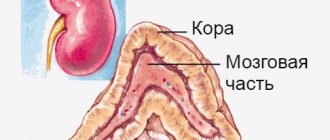Oligophrenia (recently this name is practically not used in medicine; instead, the term “mental retardation” is used to describe the disorder) is a pathology of mental development, accompanied by pronounced intellectual and cognitive deficits. The disease manifests itself at an early age; in the vast majority of cases, its etiology is associated with intrauterine developmental defects. Unfortunately, it is impossible to completely get rid of such an illness, however, with timely consultation with a doctor and early correction, social adaptation is quite possible, which will allow the patient to care for himself independently and engage in simple work activities.
Doctors at the Leto clinic use a variety of methods of psychotherapeutic behavioral correction, supportive drug therapy and rehabilitation to treat oligophrenia.
Causes of mental retardation
Oligophrenia is considered a polyetiological disease. Indeed, social factors play an important role in its development. According to research, the IQ of children who grew up in dysfunctional families is on average 20 points lower than that of children whose parents paid due attention to their upbringing and comprehensive intellectual development. Moreover, in the future, if a “problem” child is transferred to a correctional school, or if he is adopted, a rapid improvement in cognitive functions is noted.
However, the main cause of the disorder is birth defects in the development of the central nervous system. This:
- Genetic mutations that cause chromosomal pathologies (Down syndrome, Turner syndrome, etc.) and metabolic disorders of amino acids, urea, lipids, purines, polysaccharides. Oligophrenia also develops in such hereditary diseases as tuberous sclerosis, neurofibromatosis, and congenital pathologies of the skull (hydrocephalus, microcephaly).
- Antenatal malformations (adverse factors acting during pregnancy). These are infections suffered by the mother (in this regard, rubella, syphilis, toxoplasmosis are very dangerous), intoxication with heavy metals, drugs, alcohol, narcotic substances), physical damage due to injury, radiation, dysfunction and hypoxia of the placenta, endocrine disorders in women (in particular , pathology of the thyroid gland).
The following factors also play an important role:
- perinatal damage to the central nervous system: birth asphyxia, premature birth, encephalopathy caused by a critical increase in bilirubin levels, cerebral hemorrhage, etc.;
- traumatic brain injury (often as a result of a fall);
- poisoning;
- neuroinfections occurring with complications (encephalitis, meningitis);
- acute exhaustion, vitamin deficiency, malnutrition, etc.
Treatment
There are no pills that will help completely cure an oligophrenic child. But there are means that will help improve the situation. The main drug therapy is aimed at the cause of mental retardation.
If the disease occurs due to infection, antibacterial drugs and detoxification methods (for example, IVs) are used. For hydrocephalus, surgical intervention is performed.
The doctor prescribes appropriate medications for toxoplasmosis and congenital syphilis. If the endocrine system is disrupted, use hormonal medications. For enzymopathy - enzymes and diet.
Almost all patients additionally receive nootropics - drugs that help improve memory (how is that?), attention, and thinking activity.
The second part of therapy, which is carried out in parallel with medication, is constant work with the child , regardless of the degree of development of the disease and the cause.
This includes:
- training of all cognitive functions;
- self-care training;
- adaptation to society (how is that?);
- studying general educational information whenever possible.
Both parents and relatives, as well as specialists in special institutions, can work with children.
Additional sessions with a psychotherapist will only be useful. You can also join groups of moms and dads who share their experiences and support each other.
The mother of one of these children noticed her daughter’s singing talent , and after classes with vocal teachers, she now gives concerts (rarely and with a small number of listeners).
Agree that this is wonderful!!!
Symptoms and stages of oligophrenia
The main signs of mental retardation are:
- difficulties with assimilation of new information;
- difficulties with communication, social interaction;
- memory impairment, especially short-term;
- impairment of visual-spatial perception, which makes it difficult for the patient to dress independently and perform simple hygiene procedures;
- hyperactivity; in adolescence, attacks of anger and irritability are possible.
Somatic disorders are also characteristic. Many children with mental retardation are additionally diagnosed with hearing and vision problems, movement disorders (involuntary, uncoordinated movements, spasms), and are often diagnosed with epilepsy, and seizures can begin already in infancy.
In some cases (especially if mental retardation is caused by genetic defects), characteristic external signs are noted, in particular:
- blond hair, blue eyes, vitiligo due to pigmentation disorders;
- joint hypertrophy;
- protruding belly;
- “X-shaped” lower limbs;
- swelling;
- slanted eyes, flattened bridge of the nose;
- prominent cheekbones, ears pressed to the skull, etc.
Syndromes combined with different degrees of MR
Down syndrome is the most common genetic cause of intellectual disability. It is caused by a chromosomal abnormality - if normally there are 46 of them, then in this case there is an unpaired 47th chromosome. People with this syndrome can be identified by an abnormally short skull, flat face, short arms and legs, short stature, and small mouth. They process the information received poorly and remember it, they lack the concept of time and space, and their speech is poor. Moreover, such individuals adapt well to society.
Martin-Bell syndrome (fragile X chromosome). The second most common genetic cause of mental retardation. It is recognized by the following external features: increased mobility of joints, an elongated face, an enlarged chin, a high forehead, large, protruding ears. They start talking late, but poorly, or don’t speak at all. They are very shy, hyperactive, inattentive, constantly moving their hands and biting them. Men have more cognitive impairment in this category than women.
Williams syndrome (“elf face”). It occurs as a result of hereditary chromosomal rearrangement, the loss of genes in one of them. The patients have a very interesting appearance: the face is narrow and long, blue eyes, flat nose, large lips. Usually suffer from cardiovascular diseases. Rich vocabulary, good memory, excellent musical abilities, and social interaction skills. But there are problems with psychomotor skills.
Angelman syndrome (happy doll or Parsley). Caused by a change in chromosome 15. Very light eyes with characteristic spots on the iris and hair, the head is small, the chin is pushed forward, the mouth is large, the teeth are sparse and long. Severe delay in psychomotor development, significant impairment of speech and movement (poor balance, walks on stiff legs). He often smiles and even laughs for no reason.
Prader-Willi syndrome . It is characterized by the absence of a paternal copy of chromosome 15 and a number of other disorders. He is short in stature, has small arms and legs, suffers from compulsive overeating, and, as a result, obesity. Problems with short-term memory, speech, information processing.
Lejeune's syndrome (cry of the cat or 5p syndrome). A very rare and serious disease caused by the absence of the short arm of chromosome 5. The head is small, the face is round, the lower jaw is underdeveloped and the bridge of the nose is wide, so the eyes are located far from each other. The feet are turned out, the hands are small. The larynx is underdeveloped, there are vision problems, in particular, strabismus. She often cries and makes a sound similar to a kitten meowing. Motor development is delayed, and the ability to pay attention is limited.
In addition to the syndromes mentioned, intellectual disability can coexist with cerebral palsy, deafness and blindness, autistic disorders, epilepsy and other somatic and mental illnesses.
Classification
Based on the results of intelligence tests using the Wechsler method, better known as determining IQ (normally, this indicator should be above 80, IQ between 70–80 is considered a borderline form of developmental delay), 3 stages of oligophrenia are distinguished:
- mild (moronic), IQ 50–70;
- moderate (imbecility stage), IQ 35–49;
- severe and deep (pronounced imbecility and idiocy), IQ less than 34.
Preventive measures
Prevention measures are a set of simple rules and recommendations:
- identify diseases in expectant mothers that provoke the development of defects in the fetus: rubella, measles, sexually transmitted diseases;
- good obstetric care is required to prevent birth injuries, fetal hypoxia, and infection;
- a healthy lifestyle for a pregnant woman, excluding smoking, drinking, taking drugs and medications that can harm the baby;
- measures aimed at preventing women from contracting infectious diseases.
Mild mental retardation
This is the most common type of mental retardation. Outwardly, patients suffering from such a disorder are no different from a healthy person; motor and speech defects are mild . As a rule, in preschool age a child practically does not lag behind his peers in development; the pathology manifests itself at school when it is necessary to master and memorize large amounts of information, and “turn on” logical thinking. A person with such a diagnosis is quite capable of living independently and working. But he may need help with solving difficult life problems (employment, purchasing or renting housing), support is also necessary in stressful situations.
Symptoms, clinical picture
The clinical picture depends on the depth of the defect. Disorders common to all types are also present. In a general sense, they can be characterized as intellectual, volitional, mnestic and behavioral deviations. Using the example of a fairly mature patient in adolescence or adulthood, we can name the following symptoms of oligophrenia:
- Problems with abstract thinking
The patient cannot draw logical conclusions, establish connections between concepts, phenomena, is not able to draw analogies, understand metaphors, thinking is concrete, flattened, and meager in terms of breadth. External signs are a paucity of interests, an inability to generalize and build cause-and-effect relationships. The violation is clearly visible during special tests.
- Stupor
A sudden cessation of mental activity is possible, even if it is not sufficient to solve a specific problem or answer a question. After a few seconds everything returns to normal. But the sufferer can no longer return to the last mental operation, which is typical for mental retardation.
- Memory disorders
As a rule, sufferers remember simple, unambiguous facts well: numbers, names. But they are not able to assimilate a large or even insignificant amount of information in context, so that they can then retell the essence, albeit in their own words, but without distorting the meaning. Against the background of debility, this problem is noticed to a lesser extent.
- Problems with switching attention and concentration
There are deviations from adequate concentration and concentration on a specific task. This leads to low productivity in an already weak mindset. In patients with mild forms of oligophrenia, the symptom is not so noticeable.
- Poverty of speech
Small vocabulary, poor lexical structure, impossibility of constructing statements in a non-standard way. Tendency to repeat the same thing, fixation on thoughts, getting stuck. These are all typical features of the disorder.
- Poverty of emotions
The patient is not able to adequately express his emotions, because the range of experiences at the same moment is not as wide as that of healthy people. In advanced cases, the affect is even poorer. Limited to a couple of stereotypical reactions to external stimuli.
- Lack of goal setting, insufficiency of the volitional sphere
Volitional efforts are possible spontaneously, after an outburst of emotion. The rational component of thinking is weakened or completely absent. Initiative is impossible, because patients are inert. They easily fall under the influence of others. They are less critical of what they hear and see, and are easily susceptible to provocations and propaganda slogans. Even if they retain their legal capacity, they become victims of fraudsters.
- Tendency to social isolation
Due to the peculiarities of the psyche, autism, withdrawal into oneself, and a general lack of interests and will to live rapidly increase. It is not always possible to “pull” a person out of this inert, weak-willed and apathetic state. Against the background of mild degrees of the disorder, the problem is more relevant, because due to the preservation of the intellect for the most part, the sufferer is fully aware of his own problems, the inferiority of the mind. Thoughts arise about one’s own inferiority and uselessness. This can push the patient to commit suicide. There are many similar cases in the practice of psychiatrists. With a deeper defect, existential questions and reflection are not typical.
- Inappropriate emotional reactions
As a result of a lack of empathy, understanding of the emotions of others and an almost complete lack of communication skills.
- Common learning disabilities
It is difficult to teach patients to read, write, and perform basic arithmetic operations. In the mildest cases, the learning process is longer than in healthy people. In neglected ones, it is impossible to teach anything in principle.
These manifestations occur in all forms, one way or another.
The primary defect in oligophrenia is intellectual deficit; other phenomena are layered on top of the main deviation. The stages determine the depth of the violation. So, if in case of debility the speech is scant, but correct and understandable, then in case of idiocy the ability to speak is absent at all. At best, mooing, inarticulate sounds.
In children, the diagnosis is much more difficult. Because there are no objective signs that would indicate a problem. Doctors may become suspicious at about 3-4 months of a child’s life. He is not prone to emotional contacts, does not respond to spoken language, smiles little, and is irritable. Has difficulty recognizing objects, such as spoons. Doesn't want to play. All this is an expression of emotional and intellectual deficiency in the first months of life. The defect persists and may gradually worsen, leading to a state of helplessness. But not in all cases, it depends on the specific situation.
Moderate mental retardation
Cognitive deficits are much more pronounced; developmental delays are noticed already in early childhood. However, with appropriate correctional work, a child can be taught to speak, perform basic duties, and take care of himself. But such patients require constant monitoring, so they live either with their parents (other relatives) or in specialized boarding schools. Having matured, they can perform simple, monotonous work.
Diagnosis of oligophrenia
The diagnosis of oligophrenia is made in accordance with generally accepted international criteria. If the results of the Wechsler questionnaire are not indicative, other tests are used, adapted taking into account age characteristics. In addition, family history is also taken into account, and if necessary, tests are prescribed to identify genetic mutations and metabolic disorders. Differential diagnosis can be difficult, since almost 70% of patients with moderate to severe mental retardation also have other mental disorders.
To identify and determine the severity of possible organic brain lesions, it is recommended to do MRI , angiography of cerebral vessels, and radiography.
Cost of services
| CONSULTATIONS OF SPECIALISTS | |
| Initial consultation with a psychiatrist (60 min.) | 6,000 rub. |
| Repeated consultation | 5,000 rub. |
| Consultation with a psychiatrist-narcologist (60 min.) | 5,000 rub. |
| Consultation with a psychologist | 3,500 rub. |
| Consultation with Gromova E.V. (50 minutes) | 12,000 rub. |
| PSYCHOTHERAPY | |
| Psychotherapy (session) | 7,000 rub. |
| Psychotherapy (5 sessions) | 30,000 rub. |
| Psychotherapy (10 sessions) | 60,000 rub. |
| Group psychotherapy (3-7 people) | 3,500 rub. |
| Psychotherapy session with E.V. Gromova (50 minutes) | 12,000 rub. |
| TREATMENT IN A HOSPITAL | |
| Ward for 4 persons | 10,000 rub./day |
| Ward for 3 persons | 13,000 rub./day |
| Ward 1 bed VIP | 23,000 rub./day |
| Individual post | 5,000 rub. |
| PETE | 15,000 rub./day |
This list does not contain all prices for services provided by our clinic. The full price list can be found on the “Prices” , or by calling: 8(969)060-93-93. Initial consultation is FREE!
How to treat oligophrenia
Nowadays, thanks to advances in psychiatry, mental retardation can usually be recognized at a relatively early age . Thanks to regular examinations by a pediatrician and neurologist, it is possible to identify characteristic signs of the disease and determine the degree of retardation in mental and mental development.
A pronounced effect should be expected from drug treatment only when mental retardation is caused by metabolic and/or endocrine disorders. In other cases, therapy can only alleviate the symptoms of the disease. To relieve psychomotor agitation, hyperactivity, and anxiety-depressive affect, antipsychotics and tranquilizers are used. Nootropics are indicated to improve blood supply to the brain.
But the main role in the treatment of oligophrenia is given to rehabilitation and psychological correction aimed at adapting the child to society, improving speech skills, developing motor skills, coordination, and attention. Additionally, exercise therapy is recommended to improve overall health.
get more detailed information about the treatment of oligophrenia in a medical clinic by calling the 24-hour anonymous phone number 8(969)060-93-93 .
Support for people with disabilities
This disease develops in different ways, but it is very important to diagnose it as early as possible. In this case, specialists will begin to work closely with such a patient at an early age, which significantly improves his condition and quality of life.
Such assistance is necessarily personalized, that is, it is planned taking into account the individual characteristics of the patient, his needs and desires. People with this diagnosis are not the same, therefore, help for each of these individuals in the sphere of life and certain activities should have its own type and intensity.
In many countries of the world, including ours, special programs have been developed whose goal is to improve the quality of life of people with mental retardation. They are integrated, “dissolved” in society. Children with mild degrees of the disease go to auxiliary schools and kindergartens, inclusive classes in regular educational institutions. There are even groups in vocational schools where you can get an education and then work in your specialty.








